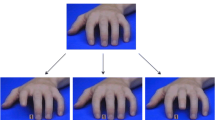Abstract
Action perception may involve a mirror-matching system, such that observed actions are mapped onto the observer’s own motor representations. The strength of such mirror system activation should depend on an individual’s experience with the observed action. The motor interference effect, where an observed action interferes with a concurrently executed incongruent action, is thought to arise from mirror system activation. However, this view was recently challenged. If motor interference arises from mirror system activation, this effect should be sensitive to prior sensorimotor experience with the observed action. To test this prediction, we measured motor interference in two groups of participants observing the same incongruent movements. One group had received brief visuo-motor practice with the observed incongruent action, but not the other group. Action observation induced a larger motor interference in participants who had practiced the observed action. This result thus supports a mirror system account of motor interference.


Similar content being viewed by others
Notes
This difference remained significant when either the first or the second baseline condition was used as the baseline value instead of the average of the two baseline conditions (t(42) = 3.32, p < 0.002, d = 1.21, and t(42) = 2.67, p < 0.01, d = 0.80, respectively).
References
Blakemore, S., & Frith, C. (2005). The role of motor contagion in the prediction of action. Neuropsychologia, 43, 260–267.
Bouquet, C. A., Gaurier, V., Shipley, T., Toussaint, L., & Blandin, Y. (2007). Influence of the perception of biological or non-biological motion on movement execution. Journal of Sports Sciences, 25, 519–530.
Bouquet, C. A., Shipley, T. F., Capa, R. L., & Marshall, P. J. (2010). Motor contagion: Goal-directed actions are more contagious than non-goal-directed actions. Experimental Psychology (in press).
Brass, M., Bekkering, H., & Prinz, W. (2001). Movement observation affects movement execution in a simple response task. Acta Psychologica, 106, 3–22.
Calvo-Merino, B., Glaser, D. E., Grèzes, J., Passingham, R. E., & Haggard, P. (2005). Action observation and acquired motor skills: An fMRI study with expert dancers. Cerebral Cortex, 15, 1243–1249.
Casile, A., & Giese, M. A. (2006). Nonvisual motor training influences biological motion perception. Current Biology, 16, 69–74.
Catmur, C., Walsh, V., & Heyes, C. (2007). Sensorimotor learning configures the human mirror system. Current Biology, 17, 1527–1531.
Cross, E. S., Hamilton, A. F. C., & Grafton, S. T. (2006). Building a motor simulation de novo: Observation of dance by dancers. Neuroimage, 31, 1257–1267.
Gates, D. H., & Dingwell, J. B. (2008). The effects of neuromuscular fatigue on task performance during repetitive goal-directed movements. Experimental Brain Research, 187, 573–585.
Gowen, E., Stanley, J., & Miall, R. C. (2008). Movement interference in autism-spectrum disorder. Neuropsychologia, 46, 1060–1068.
Heyes, C. (2001). Causes and consequences of imitation. Trends in Cognitive Sciences, 5, 253–261.
Heyes, C. M. (2010). Where do mirror neurons come from? Neuroscience and Biobehavioral Reviews, 34, 575–583.
Jansson, E., Wilson, A. D., Williams, J. H. G., & Mon-Williams, M. (2007). Methodological problems undermine tests of the ideo-motor conjecture. Experimental Brain Research, 182, 549–558.
Jeannerod, M. (2001). Neural simulation of action: A unifying mechanism for motor cognition. Neuroimage, 14, S103–S109.
Kilner, J., Hamilton, A. F. C., & Blakemore, S. J. (2007). Interference effect of observed human movement on action is due to velocity profile of biological motion. Social Neuroscience, 2, 158–166.
Kilner, J. M., Paulignan, Y., & Blakemore, S. J. (2003). An interference effect of observed biological movement on action. Current Biology, 13, 522–525.
Knoblich, G., & Flach, R. (2001). Predicting the effects of action: Interactions of perception and action. Psychological Science, 12, 467–472.
Marshall, P. J., Bouquet, C. A., Shipley, T. F., & Young, T. (2009). Effects of brief imitative experience on EEG desynchronization during action observation. Neuropsychologia, 47, 2100–2106.
Press, C., Bird, G., Flach, R., & Heyes, C. (2005). Robotic movement elicits automatic imitation. Cognitive Brain Research, 25, 632–640.
Press, C., Gillmeister, H., & Heyes, C. (2007). Sensorimotor experience enhances automatic imitation of robotic action. Proceedings of the Royal Society B Biological Sciences, 274, 2509–2514.
Prinz, W. (1997). Perception and action planning. European Journal of Cognitive Psychology, 9, 129–154.
Richardson, M. J., Campbell, W. L., & Schmidt, R. C. (2009). Movement interference during action observation as emergent coordination. Neuroscience Letters, 449, 117–122.
Rizzolatti, G., & Craighero, L. (2004). The mirror-neuron system. Annual Review of Neuroscience, 27, 169–192.
Stanley, J., Gowen, E., & Miall, R. C. (2007). Effects of agency on movement interference during observation of a moving dot stimulus. Journal of Experimental Psychology: Human Perception and Performance, 33, 915–926.
Wilson, M., & Knoblich, G. (2005). The case for motor involvement in perceiving conspecifics. Psychological Bulletin, 131, 460–473.
Author information
Authors and Affiliations
Corresponding author
Rights and permissions
About this article
Cite this article
Capa, R.L., Marshall, P.J., Shipley, T.F. et al. Does motor interference arise from mirror system activation? The effect of prior visuo-motor practice on automatic imitation. Psychological Research 75, 152–157 (2011). https://doi.org/10.1007/s00426-010-0303-6
Received:
Accepted:
Published:
Issue Date:
DOI: https://doi.org/10.1007/s00426-010-0303-6




